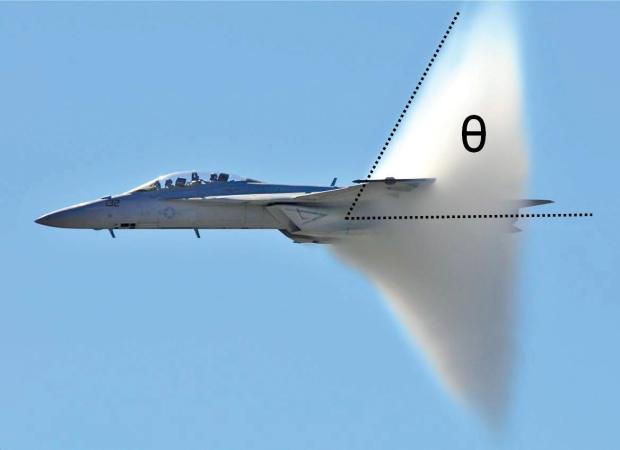When a strong explosion takes place, a shock wave forms that propagates in a spherical manner away from the source of the explosion. The shock front separates the air mass that is heated and compressed due to the explosion from the undisturbed air. In the picture below you can see the shock sphere that resulted from the explosion of Trinity, the first atomic bomb ever detonated.

Using the concept of similarity solutions, the physicists Taylor and Sedov derived a simple formula that describes how the radius r (in m) of such a shock sphere grows with time t (in s). To apply it, we need to know two additional quantities: the energy of the explosion E (in J) and the density of the surrounding air D (in kg/m3). Here’s the formula:
r = 0.93 · (E / D)0.2 · t0.4
Let’s apply this formula for the Trinity blast.
———————-
In the explosion of the Trinity the amount of energy that was released was about 20 kilotons of TNT or:
E = 84 TJ = 84,000,000,000,000 J
Just to put that into perspective: in 2007 all of the households in Canada combined used about 1.4 TJ in energy. If you were able to convert the energy released in the Trinity explosion one-to-one into useable energy, you could power Canada for 60 years.
But back to the formula. The density of air at sea-level and lower heights is about D = 1.25 kg/m3. So the radius of the sphere approximately followed this law:
r = 542 · t0.4
After one second (t = 1), the shock front traveled 542 m. So the initial velocity was 542 m/s ≈ 1950 km/h ≈ 1210 mph. After ten seconds (t = 10), the shock front already covered a distance of about 1360 m ≈ 0.85 miles.
How long did it take the shock front to reach people two miles from the detonation? Two miles are approximately 3200 m. So we can set up this equation:
3200 = 542 · t0.4
We divide by 542:
5.90 ≈ t0.4
Then take both sides to the power of 2.5:
t ≈ 85 s ≈ 1 and 1/2 minutes
———————-
Let’s look at how the different parameters in the formula impact the radius of the shock sphere:
-
If you increase the time sixfold, the radius of the sphere doubles. So if it reached 0.85 miles after ten seconds, it will have reached 1.7 miles after 60 seconds. Note that this means that the speed of the shock front continuously decreases.
For the other two parameters, it will be more informative to look at the initial speed v (in m/s) rather the radius of the sphere at a certain time. As you noticed in the example, we get the initial speed by setting t = 1, leading to this formula:
v = 0.93 · (E / D)0.2
-
If you increase the energy of the detonation 35-fold, the initial speed of the shock front doubles. So for an atomic blast of 20 kt · 35 = 700 kt, the initial speed would be approximately 542 m /s · 2 = 1084 m/s.
-
The density behaves in the exact opposite way. If you increase it 35-fold, the initial speed halves. So if the test were conducted at an altitude of about 20 miles (where the density is only one thirty-fifth of its value on the ground), the shock wave would propagate at 1084 m/s
Another field in which the Taylor-Sedov formula is commonly applied is astrophysics, where it is used to model Supernova explosions. Since the energy released in such explosions dwarfs all atomic blasts and the surrounding density in space is very low, the initial expansion rate is extremely high.
This was an excerpt from the ebook “Great Formulas Explained – Physics, Mathematics, Economics”, released yesterday and available here: http://www.amazon.com/dp/B00G807Y00. You can take another quick look at the physics of shock waves here: Mach Cone.

